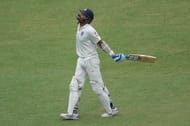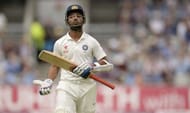India vs England 2018
As July was being consigned to the shadows and August was about to dawn, the Indian team management talked the talk. They were prepared for the five-Test showdown against England in England, they said, though it was going to be tough.
For once, the words did not ring hollow, because some members of the Test team had already spent more than a month in England playing T20s and one-day internationals before the warm-up game against Essex, and even the Test specialists, among them Rahane, Pujara and Vijay, had played an unofficial Test versus a strong England Lions contingent in preparation for the Test series.
Two matches into it, though, two matches against an England team that had won only one of its previous nine Tests, we once again have an Indian team that is finding it hard to walk the talk.

There have been positives, of course, as the optimistic psychologist is bound to say, in the form of Kohli's 200 runs at Edgbaston, Ashwin's haul at the same venue, Shami's fitness (touch wood!) and consistent spells with the ball and Pujara's infertile but weather-walling 90-ball resistance in the second innings at Lord's where India, admittedly, got the wrong end of the stick with respect to the toss, the conditions and their own team selection.
These positives have done nothing, however, to hide even partially the elephant in the Indian dressing room -- the collective and colossal failure of the top order to spend hours at the crease and/or to put runs on the board.
The failures of Vijay and Rahane
The failures of Vijay and Rahane have been particularly damning because they were expected to be the bulwarks of the Indian batting line up, along with Kohli, given that they had been the team's best batsmen during the previous tour of England and that both came into the August Tests with runs and time under their belt during the preparatory games.
So, what has gone wrong? While it is difficult to pinpoint the causes of Vijay's and Rahane's failures without being privy to the goings-on in their minds and at team meetings, what is obvious is that both men seem to have moved away from the game that brought them success.

Vijay, the Test batsman, has always been a player of two tempos, especially abroad, where long periods of stoical defence have sandwiched short but effective spurts of attacking stroke play. That appeared to change earlier this year in South Africa, however, where Vijay seemed a little too eager to get on with it, and it was not until the second innings of the final Test at Johannesburg, where his three-hour 27 was as instrumental as Kohli's and Rahane's forties in ensuring that India had a match-winning lead, that one got a glimpse of the old Vijay.
Rahane's problems seem subtler, but all his four dismissals against England thus far speak of a batsman who is not aware of his off-stump and, consequently, perhaps, of a man with a cluttered mind.

Vijay's and Rahane's diminishing returns are not isolated, however, and reflect the general inability of batsmen to construct substantial Test match innings, especially away from home. For batsmen whose surnames are not Sehwag, Hayden, De Villiers or Gilchrist, only time at the crease translates as runs and time back in the pavilion, to paraphrase Yorkshire's and England's Geoff Boycott, does not.
Even Virat Kohli, who usually ticks at a brisk rate of 70 runs per hundred balls in Test cricket, understood this at Edgbaston and had to swallow his ego against the mean and masterful James Anderson, en route to a glorious, sunshine-congratulated hundred.
Absence of long innings
As Test cricket's most capped and prolific opening batsman, Alastair Cook understands the value of the long innings better than most, but has only three scores over fifty in his last twenty-three Test outings (two of them double hundreds, a testament to Cook's continuing quest for runs, which is what keeps him in the England team) and only three more over twenty-five. Hashim Amla, another of Test cricket's all-weather batsmen, has not had it far better in recent times either, his last hundred coming ten matches ago, and his seventy-three runs over six innings in Sri Lanka raising questions about his international future.

The recent numbers churned out by batsmen of the calibre of Amla and Cook, as well as the struggles endured by those like Rahane and Vijay in England, represent as much of a threat to Test cricket as anything else.
With the shorter formats being egregiously batsmen-friendly, despite the bi-yearly ritual of tweaking rules to ensure that bowlers do not become endangered too soon, and with some grounds turning out tarmac roads even for the long format, Test matches played on sporting wickets alone hold the potential to reinstate the elemental contest between bat and ball that is at the heart of the game of cricket.
That even good batsmen fail to rise to the challenge more often than not is a sad spectacle for those like me, who still wait with bated breaths for long Test series to begin. It also makes a mockery of the ICC's Test rankings table, as most teams trounce all-comers at home and barely compete abroad.
Follow IPL Auction 2025 Live Updates, News & Biddings at Sportskeeda. Get the fastest updates on Mega-Auction and cricket news
